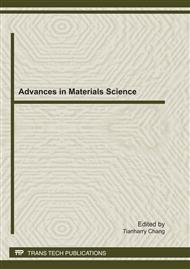[1]
Kui Qin. Based on the number of digital camera image recognition system[J], Master thesis of Shanghai Jiao Tong University. 2004: 30-45.
Google Scholar
[2]
Yanxiong Liu. Texture analysis in the metallographic image analysis system [J], Master thesis of Sichuan University. 2005: 23-56.
Google Scholar
[3]
Xinliang Ge. Based on a variety of sensor fusion for mobile robot environment recognition, Hebei University of Technology [J], 2003. 1: 1-3.
Google Scholar
[4]
GUI Yun Tian, Duke Gledhill, David Taylor. Comprehensive interest points based on imaging mosaic. Pattern Recognition Letters 24(2003)1171-1179.
DOI: 10.1016/s0167-8655(02)00287-8
Google Scholar
[5]
W. K. Wong, C.W. M. Yuen, D. D. Fan, L. K. Chan, E. H. K. Fung. Stitching defect detection and classification using wavelet transform and BP neural network [J]. Expert systems with applications 36(2009) 3845-3856.
DOI: 10.1016/j.eswa.2008.02.066
Google Scholar
[6]
Dae-Hyun Kim, Yong-In Yoon, Jong-Soo Choi. An efficient method to build panoramic image mosaics. Pattern Recognition Letters 24(2003) 2421-2429.
DOI: 10.1016/s0167-8655(03)00071-0
Google Scholar
[7]
K-T Kim,H-TKimOne-dimensional scattering center extraction for efficient radar target classification[J]IEE Proc. -Radar,Sonar Navig. ,1999,146(3).
DOI: 10.1049/ip-rsn:19990321
Google Scholar
[8]
Lindeberg. T. Feature detection with automatic scale selection [J]. International journal of computer vision, 1998. 30(2): 79-116.
Google Scholar
[9]
Ran Li. Wavelet-based image registration[J]. Computer Knowledge and Technology Papers2009. 5: 1-3.
Google Scholar
[10]
Mingjian Hong, Jianbin Lv, Dan Yang, Youli Mao. [J]. ACTA Chongqing University. 2009. 6: 16-22.
Google Scholar
[11]
Lowe. D. G. local feature view clustering for 3D object recognition [A]. In: Proc. IEEE computer society conference on computer vision and pattern recognition, Kauai, Hawaii, 2001: 682-688.
DOI: 10.1109/cvpr.2001.990541
Google Scholar
[12]
Zoghlami I. Faugeraso, Deriche R. Using geometric corners to build a 2D mosaic from a set of images. In: Proc. Of the Intl. Conf. on Computer Vision and Pattern Recognition. Puerto Rico. IEEE, (1997).
DOI: 10.1109/cvpr.1997.609359
Google Scholar
[13]
Harris, C., Stephens, M., 1988. A combined corner and edge detector. Fourth Alvey Vision Conference, pp.147-151.
DOI: 10.5244/c.2.23
Google Scholar
[14]
H. GUO. Theory and applications of shift invariant, time-varying and undecimated wavelet transform. M. S. thesis, USA: rice university, (1995).
Google Scholar


